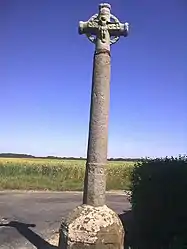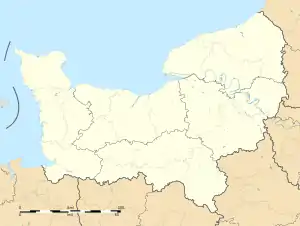Saint-Pierre-en-Port
Saint-Pierre-en-Port is a commune in the Seine-Maritime department in the Normandy region in northern France.
Saint-Pierre-en-Port | |
|---|---|
 The cross at the entrance to Saint-Pierre-en-Port | |
Location of Saint-Pierre-en-Port 
| |
 Saint-Pierre-en-Port  Saint-Pierre-en-Port | |
| Coordinates: 49°48′26″N 0°29′49″E | |
| Country | France |
| Region | Normandy |
| Department | Seine-Maritime |
| Arrondissement | Le Havre |
| Canton | Fécamp |
| Intercommunality | CA Fécamp Caux Littoral |
| Government | |
| • Mayor (2020–2026) | Emmanuel Favey[1] |
| Area 1 | 3.89 km2 (1.50 sq mi) |
| Population (2017-01-01)[2] | 831 |
| • Density | 210/km2 (550/sq mi) |
| Time zone | UTC+01:00 (CET) |
| • Summer (DST) | UTC+02:00 (CEST) |
| INSEE/Postal code | 76637 /76540 |
| Elevation | 0–96 m (0–315 ft) (avg. 100 m or 330 ft) |
| 1 French Land Register data, which excludes lakes, ponds, glaciers > 1 km2 (0.386 sq mi or 247 acres) and river estuaries. | |
Geography
A farming village in the Pays de Caux, situated some 31 miles (50 km) northeast of Le Havre, at the junction of the D33 and D79 roads. The commune has a pebble beach and some very high limestone cliffs overlooking the English Channel.
History
Several polished stone axes w+@$@#$@#;/#^;^$$$&(^&$:$*/*=^&:$^*^$#/&""--'ดเere discovered here in the 19th century, evidence of human presence in the Neolithic period (9000 to 3300 years BC). In 1970, archaeological excavations found sarcophagi of the Merovingian period (500 to 750 AD).
In the 13th century, a church was built on the site of the old cemetery. At the same time, the chapel of Saint-Gervais was built on the plateau at Boulleville (near the present-day water tower). This was destroyed in a fire in the early 18th century.
In the early 19th century, the population of the valley began a slow migration inland and away from the sea. Fires and storms regularly destroyed the modest homes of the fishing families. The growth of fishing in Newfoundland also took sailors away from the village to spend 9 months at sea.
In 1846, the mayor (the Count de Trémauville) built the town hall and a boys’ school. Three years later, he demolished the old church and cemetery, citing the lack of maintenance and very poor condition and undertook the reconstruction of the church, saving only a part of the porch of the old building.
Forty years later, like many communes in the region, Saint-Pierre welcomed tourism by those wishing to spend their leisure time by the sea.
On the hillsides, where herds of grazing sheep once roamed, second homes were springing up out of the land. This in turn led to the village developing, with more shops, handicrafts, agriculture, the revival of inshore fishing and some cultural events.
Around this time, in 1883, the Grand Hotel des Terrasses and the casino were built. They were destroyed in 1944 by the Germans.
Population
| Year | Pop. | ±% p.a. |
|---|---|---|
| 1968 | 922 | — |
| 1975 | 856 | −1.06% |
| 1982 | 853 | −0.05% |
| 1990 | 832 | −0.31% |
| 1999 | 802 | −0.41% |
| 2007 | 829 | +0.41% |
| 2012 | 842 | +0.31% |
| 2017 | 831 | −0.26% |
| Source: INSEE[3] | ||
Places of interest
- The 19th-century church of St. Pierre, with a small part dating from the 13th century.
References
- Liste des maires du département de la Seine-Maritime, 10 August 2020
- "Populations légales 2017". INSEE. Retrieved 6 January 2020.
- Population en historique depuis 1968, INSEE
External links
| Wikimedia Commons has media related to Saint-Pierre-en-Port. |
- Official website of Saint Pierre en Port (in French)